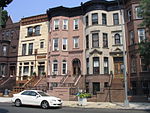Tompkins Avenue station (BMT Lexington Avenue Line)
BMT Lexington Avenue Line stationsBrooklyn railway station stubsDefunct New York City Subway stations located abovegroundFormer elevated and subway stations in BrooklynRailway stations closed in 1950 ... and 1 more
Railway stations in the United States opened in 1885
Tompkins Avenue was a station on the demolished BMT Lexington Avenue Line in Brooklyn, New York City. It had two tracks and two side platforms. It was located at the intersection of Lexington Avenue and Tompkins Avenue The station was opened on May 13, 1885, and had connections to the Tompkins Avenue Line, Marcy Avenue Line, and Ocean Avenue Line streetcars. It closed on October 13, 1950. The next southbound stop was Nostrand Avenue. The next northbound stop was Sumner Avenue.
Excerpt from the Wikipedia article Tompkins Avenue station (BMT Lexington Avenue Line) (License: CC BY-SA 3.0, Authors).Tompkins Avenue station (BMT Lexington Avenue Line)
Tompkins Avenue, New York Brooklyn
Geographical coordinates (GPS) Address Nearby Places Show on map
Geographical coordinates (GPS)
| Latitude | Longitude |
|---|---|
| N 40.6884 ° | E -73.9449 ° |
Address
Tompkins Avenue 279
11221 New York, Brooklyn
New York, United States
Open on Google Maps




